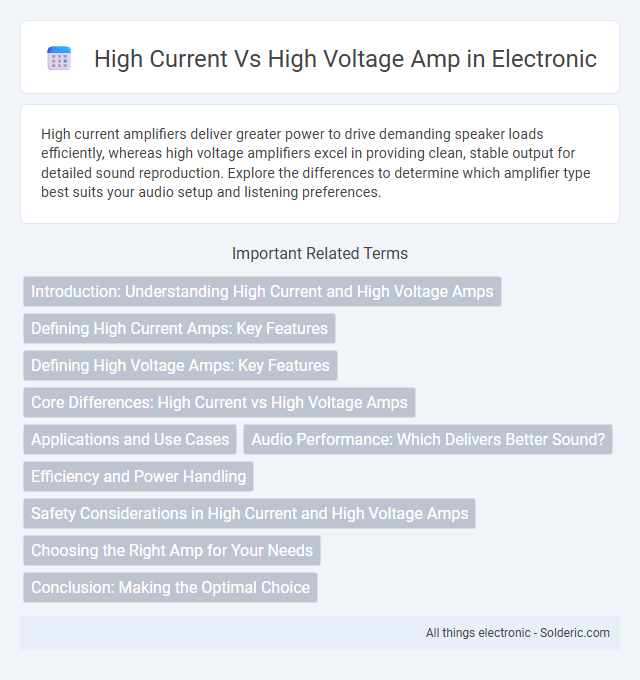High current amplifiers deliver greater power to drive demanding speaker loads efficiently, whereas high voltage amplifiers excel in providing clean, stable output for detailed sound reproduction. Explore the differences to determine which amplifier type best suits your audio setup and listening preferences.
Comparison Table
| Feature | High Current Amplifier | High Voltage Amplifier |
|---|---|---|
| Primary Function | Delivers large current to low-impedance loads | Supplies high voltage to high-impedance loads |
| Output Current | Up to several tens of amperes | Usually under a few amperes |
| Output Voltage | Typically low, under tens of volts | Can exceed hundreds or thousands of volts |
| Load Type | Low impedance (e.g., motors, coils) | High impedance (e.g., piezo actuators, tubes) |
| Typical Applications | Power amplifiers, motor drivers, audio amplifiers | Piezoelectric devices, electrostatic speakers, scientific instruments |
| Design Focus | Efficient current delivery, thermal management | Voltage stability, insulation, safety precautions |
| Protection Features | Overcurrent and thermal shutdown | Overvoltage and arcing protection |
| Power Supply Requirements | Low voltage, high current power supply | High voltage, low current power supply |
Introduction: Understanding High Current and High Voltage Amps
High current amps deliver greater amperage to power devices requiring substantial electrical flow, ensuring stable and efficient performance in high-demand applications. High voltage amps provide increased electrical potential, ideal for driving equipment that needs higher voltage to operate effectively. Your choice between high current and high voltage amps depends on the specific power requirements of your electronic or audio system.
Defining High Current Amps: Key Features
High current amps are designed to deliver a large amount of electrical current, typically measured in amperes (amps), to power devices requiring significant energy flow such as subwoofers or high-performance audio systems. Key features include low impedance output, robust circuitry capable of handling heavy loads, and enhanced cooling mechanisms to prevent overheating during extended use. Your choice of a high current amplifier ensures efficient power delivery and improved audio performance for demanding sound setups.
Defining High Voltage Amps: Key Features
High voltage amps deliver increased electrical potential, enabling devices to operate efficiently over long distances with minimal power loss. These amplifiers are characterized by their ability to handle significant voltage swings while maintaining signal integrity and reducing noise. Understanding your application's voltage requirements is crucial for selecting a high voltage amp that maximizes performance and protects equipment.
Core Differences: High Current vs High Voltage Amps
High current amps deliver greater amperage at lower voltage, ideal for driving low-impedance loads such as subwoofers or heavy speakers, ensuring strong bass and minimal distortion. High voltage amps provide elevated voltage levels at lower current, better suited for high-impedance speakers, delivering clear sound across wider frequency ranges with improved efficiency. The core difference lies in current versus voltage output, impacting the amplifier's compatibility with various speaker impedances and overall audio performance.
Applications and Use Cases
High current amplifiers excel in applications requiring powerful signal delivery for driving speakers, motors, or LED arrays, ensuring efficiency in audio systems and industrial equipment. High voltage amplifiers are essential in scenarios needing precise voltage control, such as piezoelectric devices, electrostatic speakers, and medical instrumentation. Your choice depends on whether the application prioritizes current capacity or voltage precision for optimal performance.
Audio Performance: Which Delivers Better Sound?
High current amplifiers typically provide superior audio performance by delivering more power to low-impedance speakers, resulting in tighter bass and improved dynamic range. High voltage amps excel in driving high-impedance loads with cleaner signal transmission and reduced distortion. Your choice should depend on the speaker impedance and desired sound quality, as each amplifier type optimizes audio performance under different electrical conditions.
Efficiency and Power Handling
High current amplifiers excel in delivering greater power output with lower voltage levels, resulting in improved efficiency for driving low-impedance loads such as subwoofers. High voltage amplifiers are better suited for handling higher voltage swings, enabling efficient power transfer in high-impedance circuits but may suffer from increased heat dissipation and reduced efficiency under heavy load. Selecting between high current and high voltage amps depends on the specific application's impedance requirements and power handling needs to optimize overall system performance.
Safety Considerations in High Current and High Voltage Amps
High current amplifiers pose significant safety risks due to potential overheating, short circuits, and electric shock caused by large current flow, necessitating robust insulation, overload protection, and proper ventilation. High voltage amplifiers require stringent safety measures including adequate creepage distances, reinforced insulation, and secure grounding to prevent dangerous electric shocks or arcing. Implementing safety interlocks and using components rated for high voltage and current ensure reliable operation and protect users from severe injury or equipment damage.
Choosing the Right Amp for Your Needs
Selecting the right amplifier depends on whether your audio setup requires high current or high voltage output, as high current amps deliver strong power to drive low-impedance speakers effectively, while high voltage amps excel in long cable runs and high-impedance loads. Consider speaker specifications and system demands to determine if an amplifier with high current capability ensures clarity and power without distortion or if a high voltage amp offers better signal stability and efficiency. Matching the amplifier's output characteristics to your speaker system optimizes performance, sound quality, and overall audio experience.
Conclusion: Making the Optimal Choice
Choosing between a high current and high voltage amplifier depends on your specific audio or electronic application requirements. High current amps excel at driving low-impedance loads and delivering powerful, dynamic sound, while high voltage amps are ideal for applications needing higher signal voltage swings or long cable runs. Understanding your system's impedance and power demands ensures you select the optimal amplifier to maximize performance and efficiency.
High current vs High voltage amp Infographic

 solderic.com
solderic.com